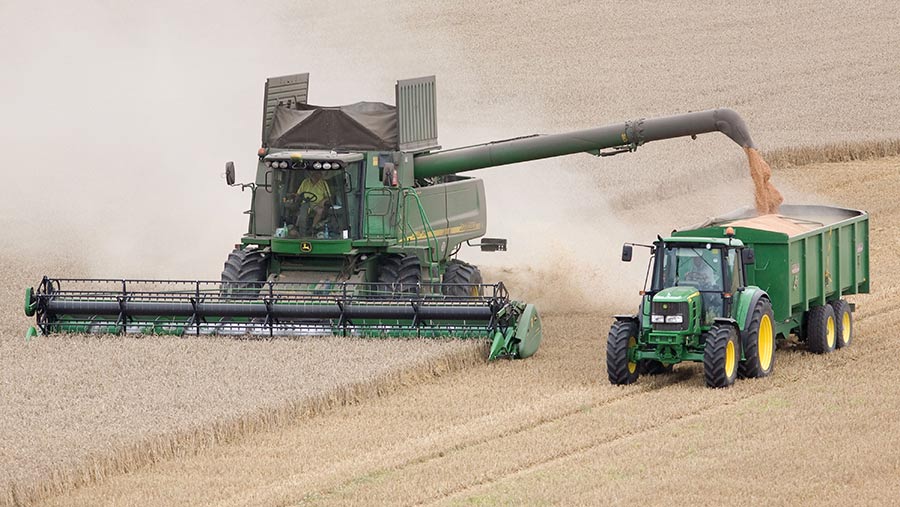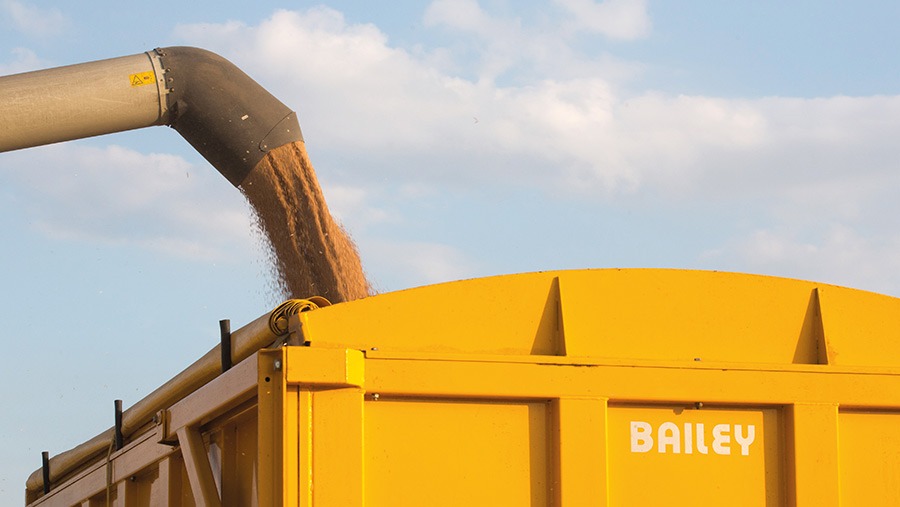Strategy pointers for selling grain in a volatile market
 © Tim Scrivener
© Tim Scrivener Wheat growers are being urged to calculate their cost of production before selling any grain for harvest 2023, as input costs have risen sharply while wheat prices have drifted lower.
Feed wheat growers harvesting 10t/ha crops this summer may have to achieve a grain price of £180/t just to break even, before rent and financing costs.
Spot feed wheat has been drifting down since late spring 2022 to trade ex-farm at just above £220/t at the moment.
Anthony Speight, senior analyst for cereals and oilseeds at the AHDB, says the Russian invasion of Ukraine in February 2022 has caused a lot of volatility in worldwide grain markets, putting a focus on good grain marketing.
“For harvest 2023, it is key for growers to know their cost of production, and if this is favourable they should consider locking in profits,” he tells Farmers Weekly.
See also: Essex wheat grower earns extra premium by hitting 14% protein
Higher fertiliser costs
Input costs have risen sharply this season, largely due to higher nitrogen fertiliser costs, but also from rises in fuel, sprays and seeds, all at a time when feed wheat prices have drifted down from more than £300/t in May 2022.
“We are not going to see prices fall to £130/t in six months, but prices have the scope to come down, although they are likely to stay historically high due to higher input costs for all wheat growers around the world,” Mr Speight adds.
Global wheat prices are falling due to bearish factors weighing on market sentiment, such as more Russian and Ukrainian wheat exports coming out of the Black Sea area.
In addition there is a big Australian wheat crop and slack worldwide demand due to fears of global economic slowdown, especially in China.
These considerations are currently outweighing bullish factors, which might potentially push prices higher.
These factors include a poor wheat harvest in Argentina, drought-affected crops last season in Europe and North America, and potential future disruption to grain exports from the Black Sea area.
Currently, very competitively priced wheat from the Black Sea area, backed up by a record Russian 2022 wheat harvest of more than 100m tonnes, are depressing global prices.
However, a Russian-Ukrainian deal to export out of the Black Sea area is only agreed until the end of March, and an escalation of hostilities could easily put any extension in doubt.
Wheat margins
Encouragingly, AHDB Farmbench data suggests that net wheat margin rose 75% for harvest 2022 due to high wheat prices and growers using fertiliser bought before the sharp price hikes.
However, 2023 harvest margins are forecast to fall 43% as fertiliser rises take effect, while wheat prices have drifted ever lower.
Overall, the AHDB calculates that overall costs for wheat growers rose 15% for harvest 2022, but are set to climb an even steeper 32% for harvest 2023.
The AHDB calculates that variable costs, such as fertiliser, seed and sprays, could increase 30% to £1,050/ha for harvest 2023.
Overheads such as machinery and labour could be as high as £750/ha, giving total costs of £1,800/ha before rent and finance charges.
This gives a production cost of £180/t for an average wheat yield of 10t/ha, so growers need to sell above that figure to make a profit margin, compared with a production cost of £140/t in 2022 and £110/t in 2021.
In addition, there is a worry that domestic demand for feed wheat could slacken if the UK’s ethanol plants scale back purchases due to high wheat prices.
Avian flu is also having an effect on feed wheat demand in the all-important poultry sector.

© Tim Scrivener
Big wheat harvest
With more winter wheat in the ground this season at the expense of spring cropping, the potential for a big wheat harvest for 2023 could put more pressure on prices.
The 2022 wheat harvest rose 11% to 15.5m tonnes due to a bigger area and higher yields, and the area for harvest 2023 is forecast to be up again, although only by 1%, according to the AHDB’s Early Bird survey.
The swing to autumn drilling in late 2022 – with wheat, barley and oilseed rape areas all up – could see the smallest spring barley crop since 2007, prompting concern over a potentially tight situation for spring malting barley at harvest 2023.
With such potential volatility, forward sales for harvest 2023 have been quiet, but are now beginning to pick up as growers look to lock in grain prices, especially with higher interest rates and the rising cost of storage.
Many growers often plan to sell one-third of their grain forward, one-third at harvest and one-third during the next season to hedge their risks, but some analysts think forward-selling may look more attractive for harvest 2023.
“If you know your breakeven point, and if that works for you, then why not sell forward,” says Mr Speight.
AHDB Early Bird survey – forecast areas of UK crops for 2023 harvest* |
|||
| Crop | Early Bird 2023 forecast | Defra June survey 2022 | Year-on-year change |
| All wheat | 1,821 | 1,809 | 1% |
| Winter barley | 450 | 433 | 4% |
| Spring barley | 632 | 671 | -6% |
| Oilseed rape | 416 | 364 | 14% |
| Pulses | 275 | 269 | 2% |
| *Figures in thousand hectares, conducted autumn 2022 | |||
UK 2022 Cereal production – Defra |
||||
| Arable crop | Harvest 2022 (m tonnes) | Year-on-year | Yield (t/ha) | Year-on-year |
| Winter Wheat | 15.540 | 11% | 8.6 | 10% |
| Winter barley | 3.212 | 17% | 7.4 | 9% |
| Spring barley | 4.173 | -1% | 6.2 | 9% |
| Oilseed rape | 1.361 | 39% | 3.7 | 16% |
Selling strategy
AHDB Salisbury monitor farmer Ben Jeans markets all his cereals and oilseed rape through his local co-operative Salisbury Cereals.
He sells 1,800t of feed wheat, 1,150t of spring malting barley, 450t of rapeseed and 280t of feed winter barley annually.

Ben Jeans © AHDB
He farms 830ha with his family at the mixed Chalk Pyt Farm near Broad Chalke in Wiltshire, some 8 miles south-west of Salisbury, on chalky loam soils.
The farm includes a 180-strong Holstein milking herd and grows grass and maize for the cattle.
He also grows 165ha of winter wheat, 150ha spring malting barley, 127ha of oilseed rape and 33ha of feed winter barley.
Anthony Speight was speaking at a recent AHDB monitor farm event in Wiltshire hosted by Mr Jeans.

